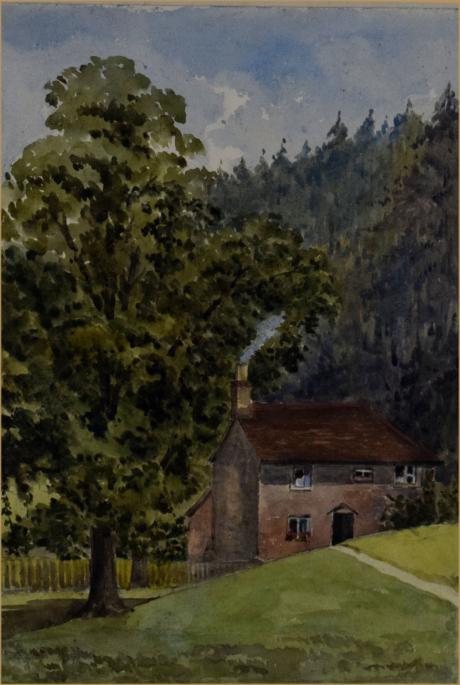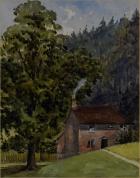inscribed and dated in the margin " Cottage Dorking August 1893"
Dorking is a market town in Surrey, England between Ranmore Common in the North Downs range of hills and Leith Hill in the Greensand Ridge, centred 21 miles (34 km) from London.
In the Georgian and Victorian periods six prominent sites in the former parish or on its boundaries became grand country estates: Leith Hill Place, Denbies (today a vineyard/hotel), Norbury Park, Polesden Lacey, Wotton House and Deepdene; five of which along with nearby Box Hill's promontory and chalk grassland slopes belong to the National Trust. Dorking is a commuter and retirement settlement with three railway stations and a few large offices of multinational companies. Similarly, Malden in 1911, noted the place was "almost entirely residential and agricultural, with some lime works on the chalk, though not so extensive as those in neighbouring parishes, a little brick-making, water-mills (corn) at Pixham Mill, and timber and saw-mills". Fine sand often in veins of pink colour, used for mortar and in glassmaking was dug, particularly in the 19th century — the Dorking Caves were accordingly excavated under southern parts of the town centre itself.
Dorking chickens with short five-toed legs are a major local breed. The town has a local government headquarters and hosts repeating loops of the FIA-ranked London-Surrey cycle classic elite category event every year. Dorking began to become more than an agricultural village as a small staging post on Stane Street, the Roman road between London and Chichester on the English Channel.
Dorking appears in Domesday Book of 1086 as the Manor of Dorchinges. It was held by William the Conqueror. Its Domesday assets were: one church, three mills worth 15s 4d, 16 ploughs, 3 acres (1.2 ha) of meadow, woodland and herbage for 88 hogs. It rendered £18 per year to its feudal system overlords.Subsequent Lords of the Manor included the Dukes of Norfolk, who lived in Dorking until they moved to Arundel. One of them is buried in Dorking churchyard. In the medieval period, Dorking was a prosperous agricultural and market town with businesses, including milling and brewing, capitalising on its position on the junction of a number of long distance roads and local tracks.
In 1750, the construction of a turnpike road made Dorking a staging post on the route to Brighton and the coast. The Bull's Head in South Street had a famous coachman, William Broad, whose portrait hangs in Dorking Museum in West Street. An inn in the centre of Dorking, the White Horse, was developed in the 18th century; previous buildings on this site belonged to the Knights Templar and later the Knights of St John.
Dorking held a big wheat and cattle market in the High Street. The poultry market was held in the corner of South Street and round Butter Hill. Here the famous Dorking fowl were sold. This breed, which has five claws instead of the normal four, was a favourite for 19th century tables, including that of Queen Victoria. Dorking lost its stagecoaches when the railways arrived, but then attracted wealthy residents who built large houses in and around the town, such as Denbies House and Pippbrook House (now with council offices in the grounds). Surrounding land and beauty spots such as Cotmandene[7] and Box Hill were donated by landowners for public use, protected by the Metropolitan Green Belt and the AONB designation of the North Downs and Greensand Ridge. Cotmandene is a 4.78 ha (12-acre) area of common land to the east of the town centre, (the name is thought to mean the heath of the poor cottages). Cricket matches were played on the heath during the 18th century and are recorded in Edward Beavan's 1777 poem Box Hill. A painting entitled A Cricket Match on Cotmandene, Dorking by the artist James Canter, dating to around 1770, is now held by the Marylebone Cricket Club.
A game resembling rugby was once played here. The two sides were unlimited in number, representing the east and west of the town. The goals were the two bridges on the Pipp Brook. The Town Crier kicked off the ball at 2 pm and stopped play at 6 pm. The game was started at the church gates and was "rioted" up and down the High Street. It ceased in 1897 after complaints by tradesmen and it was officially stopped under section 72 of the Highway Act 1835.
In the 1880s there was a proposal to supply seawater to the town from a conduit between Lancing and London. Dorking was an urban district from 1894 to 1974. In 1911 it was described in the Victoria County History, compiled for the county that year and the next, as "almost entirely residential and agricultural, with some lime works on the chalk, though not so extensive as those in neighbouring parishes, a little brick-making, water-mills (corn) at Pixham Mill, and timber and saw-mills.


